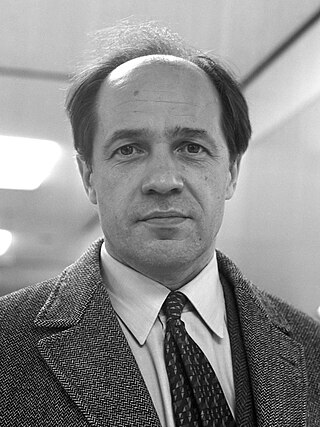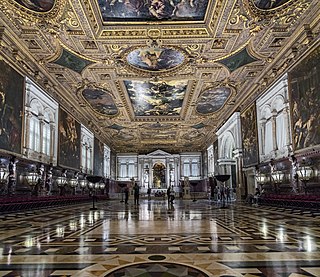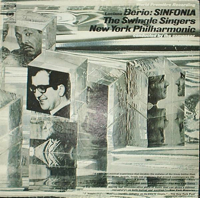
Pierre Louis Joseph Boulez was a French composer, conductor and writer, and the founder of several musical institutions. He was one of the dominant figures of post-war contemporary classical music.

Pli selon pli is a piece of classical music by the French composer Pierre Boulez. It carries the subtitle Portrait de Mallarmé. It is scored for a solo soprano and orchestra and uses the texts of three sonnets of French symbolist poet Stéphane Mallarmé and single lines from two of his other poems. At over an hour, it is Boulez's longest work.
The 12th Annual Grammy Awards were held on March 11, 1970. They recognized accomplishments of musicians for the year 1969.

The Swingles are an a cappella vocal group. The Swingle Singers were originally formed in 1962 in Paris under the leadership of Ward Swingle. In 1973, Swingle disbanded the French group, and formed an English group known initially as Swingle II and later as the New Swingle Singers, before settling on the Swingles name.

La mer, trois esquisses symphoniques pour orchestre, or simply La mer, L. 109, CD. 111, is an orchestral composition by the French composer Claude Debussy.

Folk Songs is a song cycle by the Italian composer Luciano Berio composed in 1964. It consists of arrangements of folk music from various countries and other songs, forming "a tribute to the extraordinary artistry" of the American singer Cathy Berberian, a specialist in Berio's music. It is scored for voice, flute, clarinet, harp, viola, cello, and percussion. The composer arranged it for a large orchestra in 1973.
Bernard Rands is a British-American contemporary classical composer. He studied music and English literature at the University of Wales, Bangor, and composition with Pierre Boulez and Bruno Maderna in Darmstadt, Germany, and with Luigi Dallapiccola and Luciano Berio in Milan, Italy. He held residencies at Princeton University, the University of Illinois, and the University of York before emigrating to the United States in 1975; he became a U.S. citizen in 1983. In 1984, Rands's Canti del Sole, premiered by Paul Sperry, Zubin Mehta, and the New York Philharmonic, won the Pulitzer Prize for Music. He has since taught at the University of California, San Diego, the Juilliard School, Yale University, and Boston University. From 1988 to 2005 he taught at Harvard University, where he is Walter Bigelow Rosen Professor of Music Emeritus.
Frank Scheffer is a Dutch director, cinematographer and producer of documentary film, mostly known for his work Conducting Mahler (1996) on the 1995 Mahler Festival in Amsterdam with Claudio Abbado, Riccardo Chailly, Riccardo Muti and Simon Rattle.
André Laporte is a Belgian composer.

Sinfonia (Symphony) is a composition by the Italian composer Luciano Berio which was commissioned by the New York Philharmonic for its 125th anniversary. Composed in 1968–69 for orchestra and eight amplified voices, it incorporates musical quotations to represent an abstract and distorted history of culture. The eight voices are not incorporated classically but rather speak, whisper and shout excerpts from texts including Claude Lévi-Strauss' The Raw and the Cooked, Samuel Beckett's novel The Unnamable, instructions from the scores of Gustav Mahler and other writings.
The Paris-based Swingle Singers recorded regularly for Philips in the 1960s and early 1970s and the successor London-based group continued to record, for Columbia / CBS, Virgin Classics and other record labels from 1974 to the present.

Threni: id est Lamentationes Jeremiae Prophetae, usually referred to simply as Threni, is a musical setting by Igor Stravinsky of verses from the Book of Lamentations in the Latin of the Vulgate, for solo singers, chorus and orchestra. It is Stravinsky's first and longest completely dodecaphonic work, but is not often performed. It has been called "austere" but also a "culminating point" in his career, "important both spiritually and stylistically" and "the most ambitious and structurally the most complex" of all his religious compositions, and even "among Stravinsky's greatest works".

Madrigals is the debut recording of the London-based a cappella group Swingle II, who were the immediate successors to the Paris-based Swingle Singers. The members were all new except for Ward Swingle who arranged and adapted the music for the group.

Luciano Berio was an Italian composer noted for his experimental work, and for his pioneering work in electronic music. His early work was influenced by Igor Stravinsky and experiments with serial and electronic techniques, while his later works explore indeterminacy and the use of spoken texts as the basic material for composition.
Elizabeth Laurence is a classical mezzo-soprano singer. She is best known for her performances of 20th century operatic repertoire, and has created several operatic roles.

Le Visage nuptial is a secular cantata for soprano, contralto, choir of women and orchestra by Pierre Boulez. Originally composed in 1946–47 on a poem by René Char for two voices, two ondes Martenot, piano and percussion, the work, revised in 1951–52 in a version for voices and orchestra, was premiered on 4 December 1957 in Cologne conducted by the composer. The score was further revised in 1989, removing the quarter tones present in the second and fifth parts of the 1951–52 version, while revising the orchestration. A version with final revisions by the composer was premiered on 25 February 2014 at the Cité de la Musique in Paris during the closing concert of the festival Présences of Radio France.

Coro is a large scale composition for forty voices and forty instruments by Italian composer Luciano Berio.

Cries of London is a composition for eight voices by Italian composer Luciano Berio. Originally composed for six voices in 1974, it was expanded in 1976.
George Newson was an English composer and pianist who made important contributions to British electronic and avant garde music during the 1960s and 1970s and who subsequently composed large and small-scale works in many musical forms and styles, from songs and chamber music to choral works and opera. As a photographer, Newson took portraits of many of his composer contemporaries.
The Concerto for Two Pianos and Orchestra was composer by Luciano Berio between 1972 and 1973 on a commission from the New York Philharmonic. Its world premiere was given by the pianists Bruno Canino and Antonio Ballista and the New York Philharmonic conducted by Pierre Boulez at Philharmonic Hall, New York City, on March 15, 1973. The piece is dedicated to Janice and Norman Rosenthal. The concerto has a duration of roughly 25 minutes and is cast in a single continuous movement.







